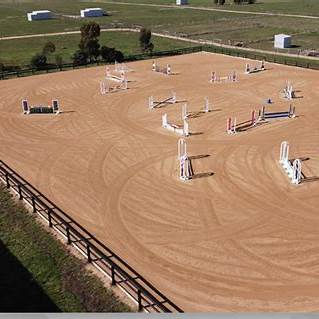Choosing the Right Sand for Your Equestrian Arena
- sean69722
- Jun 25
- 3 min read
When building or maintaining an equestrian arena, selecting the right sand is crucial for both the performance of your horse and the longevity of your facility. The type of sand you choose can affect the footing, drainage, and overall experience for the rider and horse. In this guide, we will explore the importance of choosing a purpose-blended equestrian silica sand, the drawbacks of alternatives like washed river sand, and tips on how to make the right decision for your specific needs.
Understanding Arena Sand
Arena sand is not just any sand; it is specifically formulated to provide a safe, durable, and comfortable surface for riding and working horses. Sand can vary widely in texture, particle shape, and mineral composition, all of which influence its performance in an arena setting.
A high-performance equestrian arena relies on a footing that offers:
Shock absorption
Traction
Drainage
Stability
This is where silica sand blends outperform general-purpose or washed river sand. While river sand is commonly available and used in construction, it lacks the consistency and structure needed for equestrian use. Equestrian silica sand, by contrast, is graded, washed, and blended specifically for arena applications.

Types of Arena Sand
When selecting sand for your equestrian arena, it’s essential to understand the differences in sand types, especially between washed river sand and engineered silica blends.
1. Washed River Sand
Pros: Readily available, relatively inexpensive.
Cons: Highly inconsistent particle size and shape, prone to compaction and dust, poor drainage over time. Can lead to uneven surfaces and increased risk of injury.
2. Equestrian Silica Sand Blends
Pros: Specifically graded for arena use, excellent drainage, reduced compaction, consistent particle size and shape. Offers superior grip, cushioning, and performance under hoof.
Best For: All riding disciplines including dressage, show jumping, lunging, and flatwork.
By choosing a silica sand blend, you're investing in a purpose-built footing material that improves both the performance and safety of your arena.

How Long Does Arena Sand Last?
The longevity of arena sand depends on several factors, including usage, climate, and maintenance. However, the type of sand used plays a major role:
Washed river sand tends to break down, compact, and lose effectiveness much sooner due to its mixed grain structure and impurities. It may need replenishment or full replacement within a few years.
Silica sand blends maintain their structure and performance for 5–10 years or longer with proper maintenance. Their angular, hard-wearing particles resist breakdown and reduce dust, ensuring a longer-lasting footing.
Recommended Footing Depth
For optimal performance and longevity, most equestrian arenas using silica blends are installed to a depth of approximately 110 mm (11 cm). This allows the sand to provide proper cushioning and stability while preventing the base from being exposed.
High-quality arena footing installed at an ideal depth of 110 mm for peak performance.

Final Thoughts on Choosing Arena Sand
Choosing the right sand for your equestrian arena is a critical decision that affects both safety and performance. While washed river sand may be tempting due to availability and cost, it falls short in delivering the structure, longevity, and quality your horses deserve.
Equestrian silica sand blends are the gold standard for a reason: they’re engineered to deliver optimal traction, drainage, and comfort—providing a safe, consistent footing that lasts.
By investing in the right footing material and maintaining it properly, you’ll ensure your arena remains a top-performing surface for years to come. Ready to upgrade? Talk to your local arena specialist about the best silica blend for your riding style and arena design.
Please call/wattsapp Sean on 068-211-0412 or email: sean@harrogateconstruction.co.za






Comments